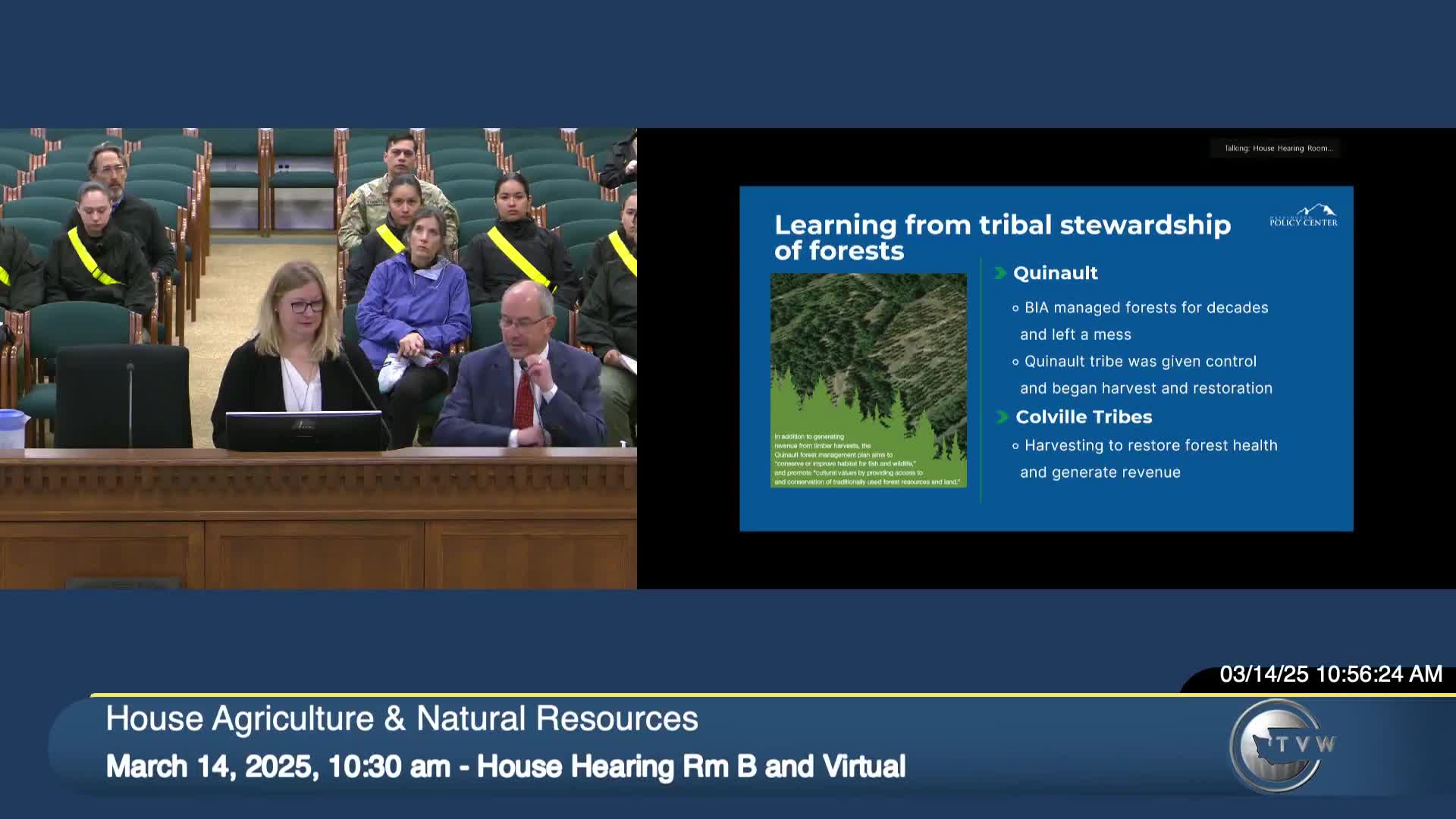Experts tell committee tribal stewardship and Good Neighbor Authority can speed forest restoration and reduce wildfire risk
March 14, 2025 | Agriculture and Natural Resources, House of Representatives, Legislative Sessions, Washington
This article was created by AI summarizing key points discussed. AI makes mistakes, so for full details and context, please refer to the video of the full meeting. Please report any errors so we can fix them. Report an error »

Todd Myers, vice president for research at the Washington Policy Center, told the House Agriculture and Natural Resources Committee that well‑executed local stewardship—including tribal forest programs—provides models for healthier, fire‑resilient forests. "The managers in Washington, D.C., could not match the knowledge and accountability of the people who are on the ground," Myers said when describing Quinault and Colville tribal stewardship arrangements he has worked on.
Myers told members the state has roughly 1,200,000 acres categorized as needing treatment to address forest health problems; about 42% of that acreage is on federal land. He described common treatments—controlled burns, mechanical thinning (sometimes called “firewising”), and selective or regeneration harvests—and said these approaches reduce overstocking that creates the standing‑kindling conditions that fuel catastrophic wildfire.
Myers emphasized Good Neighbor Authority (a federal mechanism used by states, counties and tribes) as a practical tool to accelerate work on federal lands. Under that authority, he explained, a non‑federal partner signs an agreement with the U.S. Forest Service, the Forest Service completes NEPA review, and the partner can manage stewardship operations; revenues from harvests can be placed in a revolving account to fund further projects. "Good Neighbor Authority is a really fantastic tool to do that," Myers said, noting that Congress expanded access to revolving accounts for tribes in recent action.
On carbon storage, Myers summarized research showing managed forests can produce net greenhouse‑gas benefits while also generating social and economic returns; he cited a California state analysis and work by the U.S. Forest Service Pacific Northwest Research Station showing actively managed forests often store more carbon over time than unmanaged stands that are subject to high‑severity fires. He cautioned that old growth forests are valuable habitat but are not optimal as carbon‑storage projects because their slow carbon flux and risk of decay/fire change the accounting picture.
Committee members asked about program scale and funding. Myers noted Good Neighbor Authority projects exist in Washington but have operated at modest scale to date and suggested the state consider funding operating overhead on a capital basis to increase multi‑year capacity for multi‑year federal contracts.
Ending: Presenters offered follow‑up materials and committee members discussed connecting in the interim to explore ways to grow restoration work and flexible funding approaches.
Myers told members the state has roughly 1,200,000 acres categorized as needing treatment to address forest health problems; about 42% of that acreage is on federal land. He described common treatments—controlled burns, mechanical thinning (sometimes called “firewising”), and selective or regeneration harvests—and said these approaches reduce overstocking that creates the standing‑kindling conditions that fuel catastrophic wildfire.
Myers emphasized Good Neighbor Authority (a federal mechanism used by states, counties and tribes) as a practical tool to accelerate work on federal lands. Under that authority, he explained, a non‑federal partner signs an agreement with the U.S. Forest Service, the Forest Service completes NEPA review, and the partner can manage stewardship operations; revenues from harvests can be placed in a revolving account to fund further projects. "Good Neighbor Authority is a really fantastic tool to do that," Myers said, noting that Congress expanded access to revolving accounts for tribes in recent action.
On carbon storage, Myers summarized research showing managed forests can produce net greenhouse‑gas benefits while also generating social and economic returns; he cited a California state analysis and work by the U.S. Forest Service Pacific Northwest Research Station showing actively managed forests often store more carbon over time than unmanaged stands that are subject to high‑severity fires. He cautioned that old growth forests are valuable habitat but are not optimal as carbon‑storage projects because their slow carbon flux and risk of decay/fire change the accounting picture.
Committee members asked about program scale and funding. Myers noted Good Neighbor Authority projects exist in Washington but have operated at modest scale to date and suggested the state consider funding operating overhead on a capital basis to increase multi‑year capacity for multi‑year federal contracts.
Ending: Presenters offered follow‑up materials and committee members discussed connecting in the interim to explore ways to grow restoration work and flexible funding approaches.
View full meeting
This article is based on a recent meeting—watch the full video and explore the complete transcript for deeper insights into the discussion.
View full meeting
